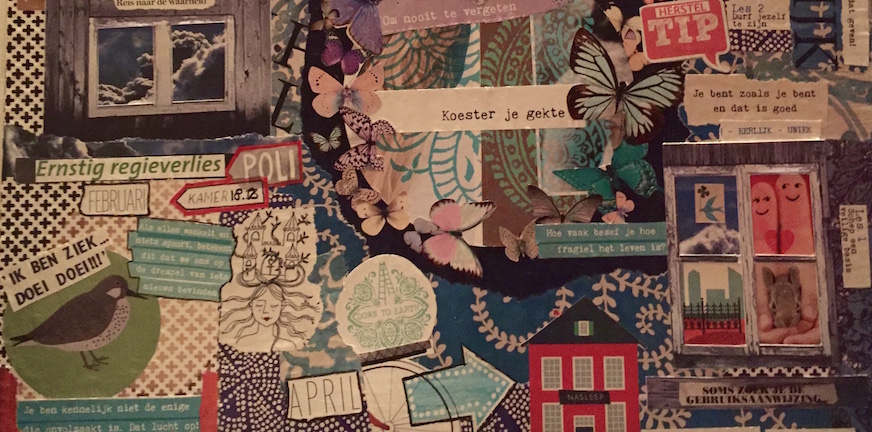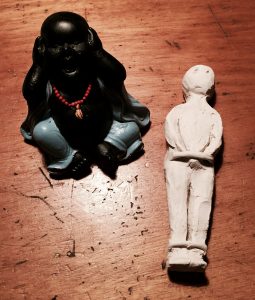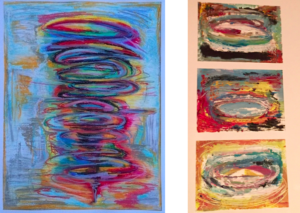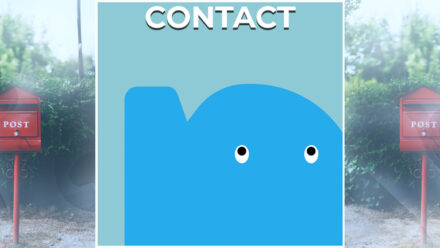
After a period of intense stress, Amber, who works as a creative therapist herself, eventually slipped into psychosis. She ended up in the psychiatric unit of a general hospital, where she received, indeed: creative therapy. “Looking back on it,” she now says, “seeing the effect of this treatment type from the side of the patient was a remarkable experience.”
Uncontrolled anxiety
“When my psychosis was at its peak, I was especially struggling with very frightening delusions. The fear went out of control. A permanent battle raged inside my head, for weeks on end. The thoughts would never stop screaming, making it impossible for me to focus on my surroundings, or to sleep. No matter how hard I tried, I kept getting sucked into my internal battle and could not scape. This exhausted and disrupted me physically as well. I was so overstimulated that all the sounds in my environment blended into one big chaotic noise. I also had strange sensations, such as the feeling that spiders were crawling all over my body.
Eventually I could no longer tell reality from delusion, and every thought that popped up immediately seemed ‘true’. What made it extra difficult to tell them apart, was that my ideas and fears were actually based on events that really happened. Each delusion had a bit of truth to it, and the other way round. “
“This artwork shows how I felt inside in that time.”
In these psychotic times, every coincidence was loaded with meaning. Every little detail became significant
“I remember a time when the power went down at home. Sheer coincidence of course, but my thoughts told me: ‘someone is tampering with the power switches, and now they are coming for us.’ I was literally hiding behind my son, terrified as I was… But somehow I could still realise that this feeling was not correct.”
Amber managed to stay in touch with reality enough to understand the situation she was in. That something had to happen, and that her son needed care. It still took a while before she was able to explain to him how she was feeling. Insofar as that is possible at all. Eventually she was admitted to the psychiatric ward of a hospital, where she quickly received creative therapy. This seemed a bit odd at the start, because of her own background as a creative therapist. But the crafting room quickly started to feel as a candy store, where she enthusiastically crafted away with various materials.
The first thing she made was a simple bowl of clay. It took her weeks to complete it.
“This made me realise for the first time again that I was able to focus on something, to live in the here and now. For weeks on end, I did nothing else except working the clay with my hands. Feeling the material again and again, sensing the texture and the shape. That really grounded me in reality.”
The early stages of therapy were all about feeling and experiencing
I had to learn to stay with both feet in the present, without ‘taking off’
Further into the process, the focus changes to learning about yourself; reflecting on the process of creation. What does it say about you? What does it mean for your life? How can you keep going on?
“And that is the main difference between a daily hobby and creative therapy. The Buddha sculpture in the picture: I bought that somewhere and painted it a bit. Yet it is a meaningless object to me. But the miniature I made myself, that truly feels like it belongs to me. It shows something about me as a person.”

“When being admitted, I first entered an observational group, with several assignments. This was still an addition to the process of diagnosis. Later on, the group became more therapeutic.
One of our assignments was creating that miniature, resembling how you feel
A simple task, but at that moment I was still overwhelmed by anxiety. And so I made a big deal out of it, thinking I had to succeed in making a beautiful work in fifteen minutes. And of course the result looked awful. I felt really bad about it, and had already thrown it in the garbage can. But still the miniature clearly displays how I was feeling. My hands and feet bound behind my back. Defeated. Mute. Surrendering.”
Each of the group members made their own miniature and discussed them together. “The power of arts therapy also lies in such group discussions,” Amber explains. “During the reflection, the process really hits home. We also looked at each other’s creations and shared how they made us feel. This also offers the opportunity to speak up about your own feelings.”
Creative therapy does not mean you have to be an artist
Amber made the mistake of forcing herself to make a masterpiece. “At first I felt incompetent beyond words. I was still in the phase of being afraid to be exposed, so vulnerable and afraid of everything. Even for what would come out of my own hands. That realization was hard to accept.”
Some of my psychotic images had also become dear to me, in a way. I would even miss them if they had to go
“I was never encouraged to visualize the images from my psychosis. Which was a good thing. Especially when you are still overwhelmed, this can be risky. But when I had found some ground beneath my feet again and could look at my psychosis from a distance, the desire came to visualize some of those moments. After all, psychosis means going through an incredible experience, which is not without its positive sides, in a strange way. The anxiety I had, was too scary for me to visualize, and something I gladly wanted to get rid of. But other aspects of the experience, were actually quite valuable.”
“One such experience I can clearly remember. It was the 16th of January (about two weeks before my admission), and the moon was full that night. I was standing in the garden, under that ‘great Luna, telling me great stories’. Everything suddenly seemed so crystal clear to me, as I saw how everything was connected and what I had to do from here. ‘Clean up the mess behind you, for this is a cosmic revolution’. It simply felt that way.”
“The feeling was grandiose, and full of meaning and significance. My mission was to get rid of all that troubling mess that filled my life. I now had a quest. This artwork also shows that incredibly detailed way of thinking. How everything is related to everything, as if the greatest insights are being revealed to you. The light that shines on you. Suddenly everything was clear to me…
That moment in the garden was the greatest.
Not long after, I was admitted.
Visual therapy is often done in groups, but also individually
“I was part of a group where everyone worked both individually and in groups. We all got the same assignments. In both forms, however, your own process is the main focus. Additionally, the work was also ‘tailored’. When I was home again, and no longer received daily treatment, I still received assignments from my creative therapist for a while. She would email them. But I had a strong tendency to become passive. And then I would sit there… and sit there… until an hour had passed.
Then we decided that she would give me an easier assignment each week. One that would not force me to think big. At the end of the week I would send her a picture of my creation, simply to remain active. And in this way we found a method that would suit me personally, from an individual approach.
The function of creative therapy is communication
Every day, the creative therapy group started with a short attention practice: the how-am-I-doing group talk. What are you experiencing? Where do you feel it? And what does it look like to you?
Amber gained a lot from these talks, simply by taking a moment to realise how she was actually doing and describing her state in an expressive way. The questions themselves were of the kind she could never answer in words.
“How are you?” No clue, how should I know? I had no words to describe it. My experiences were out of the ordinary. And sometimes words can also destroy an inner experience. Can’t I just be doing as it is, without needing to describe myself in a way that makes sense to anyone else? It is what it is, and I have no idea why. These are my feelings, and that’s that.”
Amber filled whole booklets with her drawings. And she kept them all. The drawings reveal a process, her process, which is valuable. “They are certainly not high art, but that is not the point. I have to say: they did get more amusing over time, as I added more and more details to them.”
“With such a simple exercise, you can get insights into what is happening to you, even if you are not able to talk about it. This booklet has a fixed pre-structure, so anyone can get to work on it. It can offer a starting point for further communication and exploration. A creative therapist could, for instance, ask you to make a drawing or painting to further investigate what is actually happening with you. That is the point where it gets truly self-reflective.
Creative therapy made me realise I can do things again. My hands can create, and I can even recognise that I am the creator. Every bit of it is mine.

“That is the thing with creation: you cannot escape yourself. You have the experience of the process, and the eventual product. Each of your acts leaves a visible trace. You simply cannot deny that this creation you are looking at is indeed yours. And neither can you deny that each detail comes from you, and thus reveals a lot about your personality. That makes it very scary, but also opens doors to visualize certain aspects of yourself, towards self-reflection. What is troubling you? And what does that look like?”
With the help of arts therapy, you can shape your experiences into an object and then look at them from a distance. You can reflect on yourself with the aid of a tangible object. One that has meaning and reveals things about you.
Everything displayed here, each of my creations, contains a piece of me. They are my stories, and show my personality
“This drawing was another assignment. One for which we had five minutes: draw a tree…” I really was not doing well back then, still in the first weeks of my admission. Then someone said out of nowhere: ‘Wow! Have you seen Amber’s work? She can really draw!’
I was not convinced of that at all, but the admiration of someone else had me thinking again: ‘Aha! So I do have talents. I really am somebody.’
For the first time I felt competent again, and recognised my true self. I say my own style of drawing and realized: ‘this tree is indeed really mine, created in my own way’. That means I am still there. I have not lost myself completely yet!’
Apart from that, it’s just a tree. But it was my tree. And that’s what was important. That is why it had value.”
Amber is now working again as an orthopaedist after her admission and daily treatment. She is also developing her skills as an experience expert, involved with a peer group for former mental patients.




Comments: